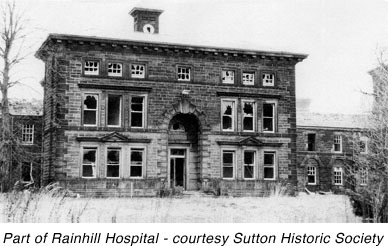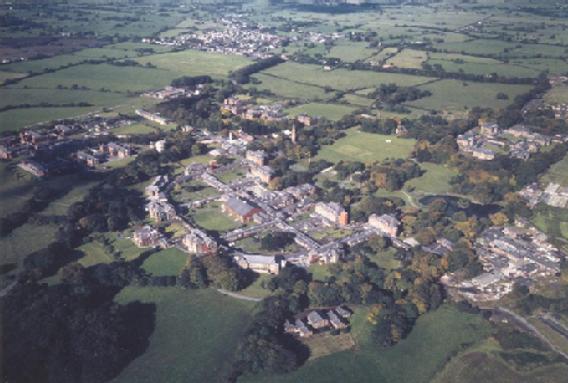'Receptacles for the Insane': Accommodating Pauper Lunacy in Nineteenth-Century Lancashire
Catherine Cox and Hilary Marland

Throughout the second half of the nineteenth century, the county of Lancashire recorded the second highest rates of confinement of pauper lunatics in England. By the early 1880s around 4,000 pauper patients were housed in Lancashire’s four county asylums and a further 3,000 in workhouses and private asylums. The Lancashire asylum system was set up under the 1808 and 1845 English Lunacy Acts. The first public asylum to be opened in the county was Lancaster County Asylum, later known as Lancaster Moor Hospital. Established in 1816 to accommodate just over 200 patients, it was the fourth asylum opened under the 1808 Act. County asylum provision was augmented when Rainhill and Prestwich Asylums were set up in Liverpool and Manchester in 1851. Both institutions were originally built to accommodate between 400 and 500 patients but the pressure of admissions placed on these asylums was both immediate and immense.
Quickly the asylums became severely overcrowded and the need to expand facilities could not be ignored. One response – also adopted in other English counties – was the addition of annexes and new buildings to existing institutions. An annex was opened at Rainhill for an additional 1,000 patients in 1886 while accommodation at Prestwich, near Manchester, expanded to 1,291 beds by 1883. Another response was to open seperate institutions – in 1873 a fourth county asulum was opened at Whittingham at Preston to accommodate 1,100 patients and within a decade a 674-bed annexe was added. A fifth asylum was opened at Winwick in Warrington in 1902 and even before it took in its first patients the local authorities were searching for a suitable site for a sixth institution.

Whittingham Asylum
|
Joseph Stantenbeck, 41-year-old, married, model maker, was admitted to Rainhill Asylum on 16 February 1871. Joseph was a German Roman Catholic who was diagnosed with mania and general paralysis of the insane. On admission, he was reported to be experiencing the ‘delusion that he is very wealthy, has one hundred million dollars, sixty ships & sixty railroads’. While in the asylum he was described as being ‘quiet & orderly in his behaviour’ and being ‘very much distressed about his family not knowing where he is, paper was given to him on which he wrote a few german words’. In July, he received a letter from his wife ‘but he wont [sic] answer it, as he says he will go to New York in two days.’ Joseph’s physical and mental condition steadily declined – he was confined to his bed in the padded room and developed bedsores. He eventually died at Rainhill Asylum in January 1872. (LRO M614 RAI/11/5, Rainhill Asylum Male Casebook, May 1870 – Dec 1873, p.51) |
Remarkably, these massive asylum complexes quickly filled as each new facilty was opened and the supply of pauper lunatics seemed inexhaustible. Large numbers of patients – Irish and non-Irish – ended up in local workhouses and private asylums such as Haydock Lodge which was licensed to house 400 pauper patients in 1846. As the public asylums established themselves in the 1850s, their medical superintendents opposed attempts by Poor Law authorities to retain cases of lunacy – a cheaper option for the county. In practice, there was considerable traffic between the two institutions, and between the asylum and the prisons. Yet, by the 1880s, as asylum doctors struggled to manage the overcrowded conditions in their institutions and became more and more frustrated with the accumulation of ‘incurable’ and ‘chronic’, long-stay patients, they resisted the attempts of Poor Law officials to ‘dump’ increasing numbers of chronic cases from the workhouses into their wards.
|
In March 1873 Margaret Murphy was removed from Walton Workhouse, where she had resided for several years, to Rainhill Asylum. She had entered the workhouse after being found wandering in Bootle and was originally apprehended on the street by the police. It was believed she had come from America and though aged only 41 years, she was described as an old woman. Though generally very withdrawn while in the asylum, she could be very violent at times, rushing ‘upon other patients to injure them’. In December 1875, she was moved from Rainhill to Whittingham Asylum where she died in June 1890. (LRO, M614 RAI/8/6 Rainhill Asylum Casebook, Jan 1870–Oct 1873, p.230;
LA QAM 4/2: p.89; HRW/7/1-16 Whittingham Asylum/Hospital Patient Register, 1873-1924, no.1146)
|
Margaret shared the fate of large numbers of Irish patients who ended up dying in what were described in the 1890s as the ‘overgrown Asylums’ of Lancashire county asylum system.
Further Reading:
Catherine Cox, Hilary Marland and Sarah York, ‘Itineraries and Experiences of Insanity: Irish Migration and the Management of Mental Illness in Nineteenth-Century Lancashire’, in Catherine Cox and Hilary Marland (eds), Migration, Health and Ethnicity in the Modern World (Palgrave Macmillan, 2013), 36-61.
John Walton, ‘Lunacy in the Industrial Revolution’: A Study of Asylum Admissions in Lancashire, 1848-50’, Journal of Social History 13:1 (1979), 1-22.
